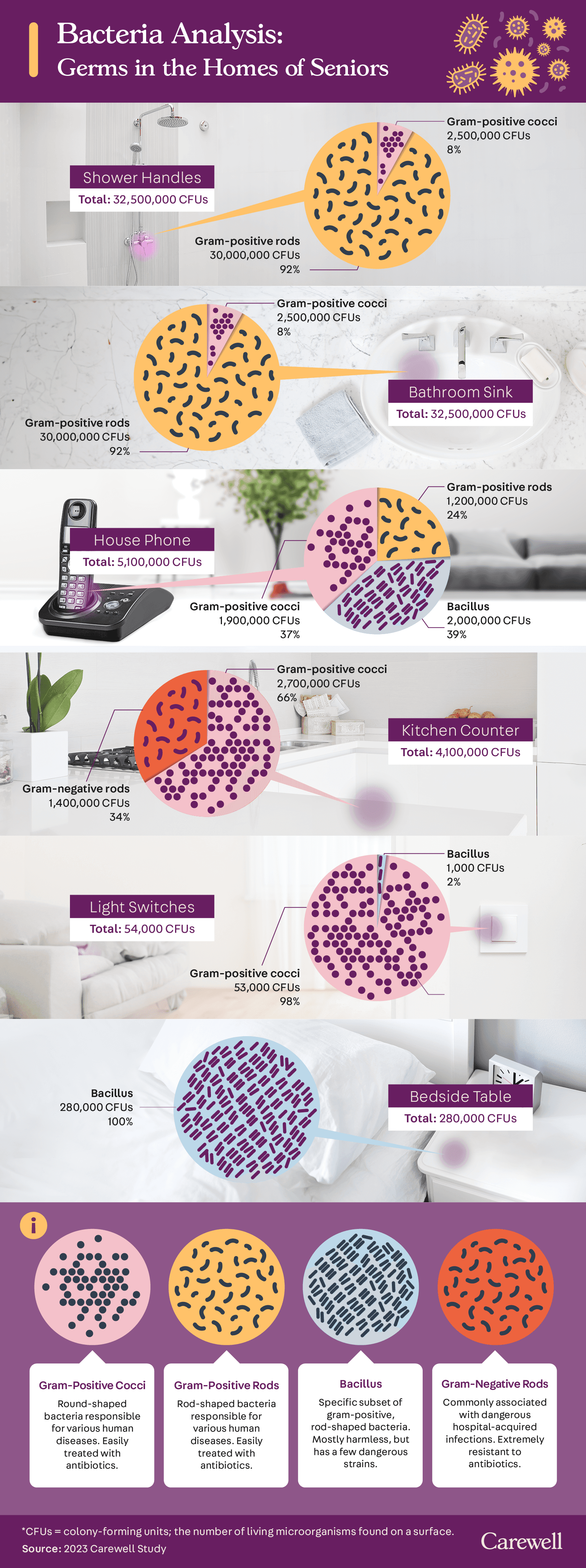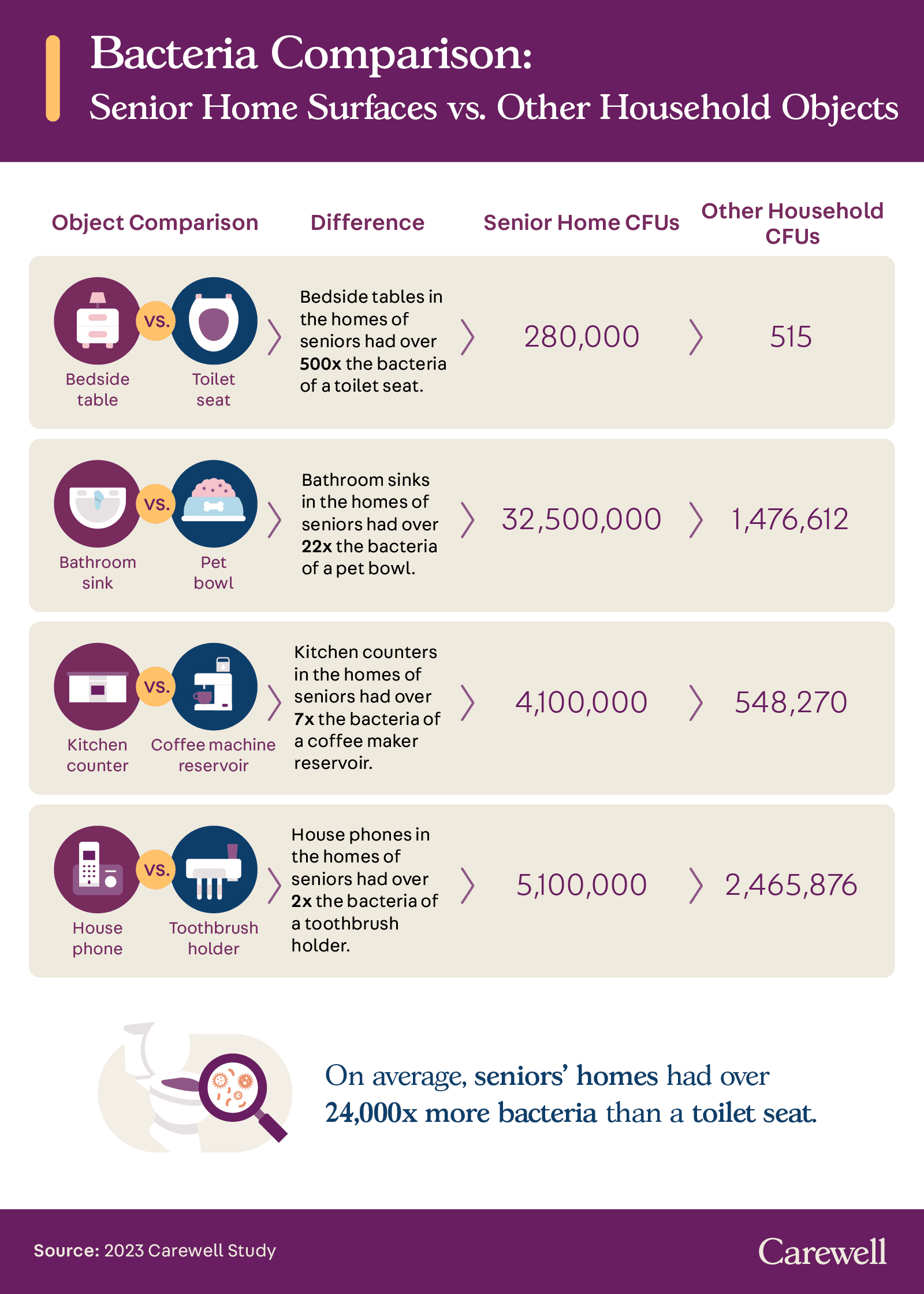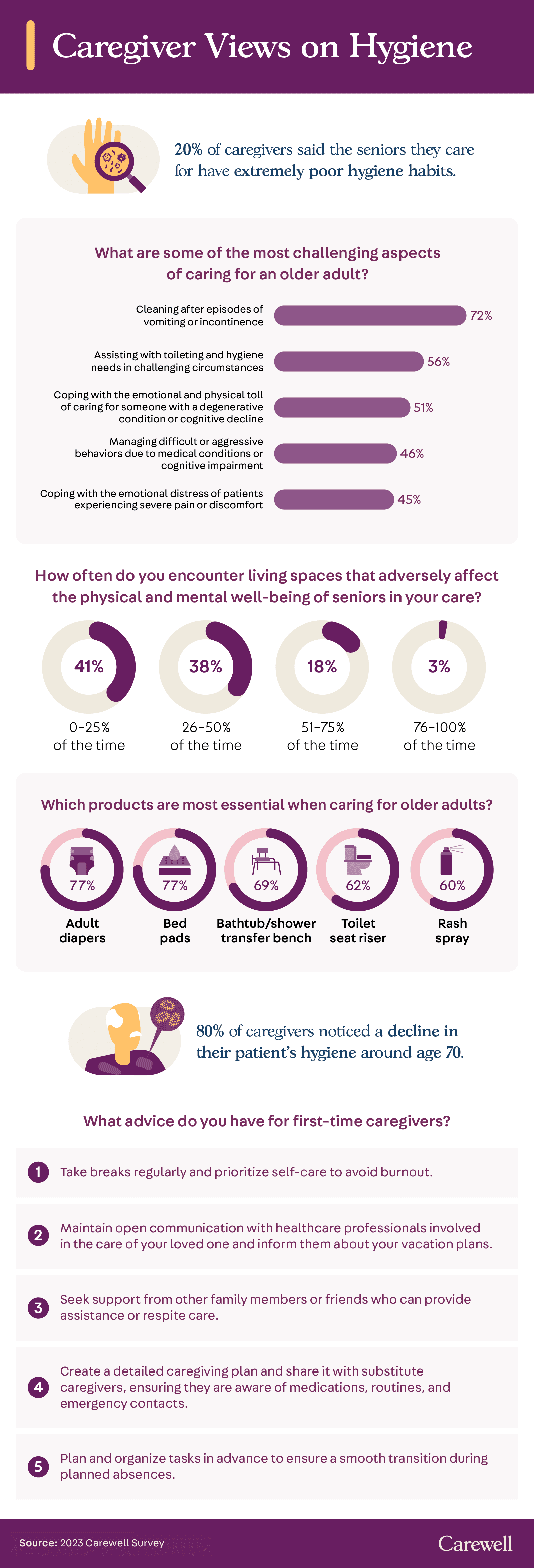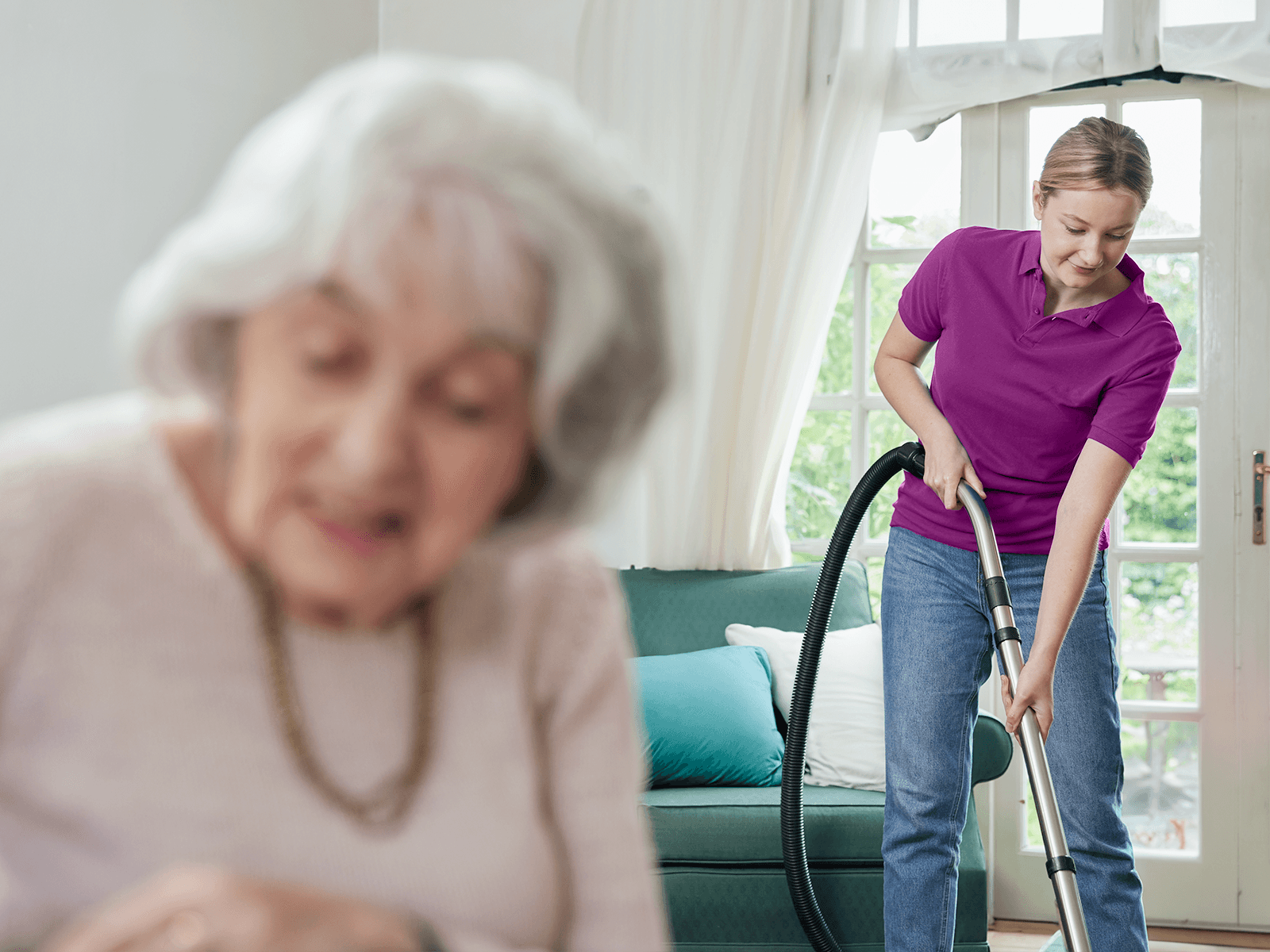Navigating Hygiene in Senior Home Care
Key Takeaways
The average senior’s home has over 24,000 times more bacteria than a toilet seat.
The bedside table in an elderly person's home had over 500x the bacteria of a toilet seat.
The bathroom sink of an elderly person's home had 22x the bacteria of a pet bowl.
Keeping Seniors’ Homes Clean
Cleaning and sanitizing older adults’ living spaces is vital when caring for their health and wellness, but we know keeping a home germ-free is challenging. Armed with cotton swabs and curiosity, we ran swab tests on various surfaces in seniors’ homes to find the germiest places that could use some extra attention. We also surveyed 235 incredible caregivers to gain insights into how they fight off germs in the homes of those they care for. Let’s dive into the details to learn how to make seniors’ homes cleaner and safer.
Searching for Bacterial Hot Spots

They say it’s important to know your enemy, so let’s learn a little about the types of bacteria we encountered in our swab tests. Our swab samples went through gram and stain tests to identify the types and numbers of germs in the average senior’s home.
Gram-positive cocci
Gram-positive cocci occur naturally on our skin but can cause serious infections if they enter the body and begin to grow. Some gram-negative cocci infections include cellulitis, endocarditis, prostatitis, MRSA, pneumonia, meningitis, staph infections, and strep throat.
Gram-positive rods
Gram-positive rods are fairly harmless to the general population but can be highly dangerous for those with weakened immune systems. Infections caused by this bacteria are very responsive to antibiotic treatment. Examples of gram-positive rod infections include botulism, diphtheria, and colitis.
Bacillus
Bacillus is a subset of gram-positive, rod-shaped bacteria. Bacillus are generally harmless to humans, but certain strains cause food spoilage, leading to food poisoning. Additionally, one strain of bacillus causes anthrax, but it’s quite rare.
Gram-negative rods
Gram-negative bacteria are the most dangerous bacteria because they are highly antibiotic-resistant. Some gram-negative rod infections include E. coli, salmonella, and Legionnaires’ disease.
In gathering our bacteria samples, each surface underwent three swabs to ensure thoroughness. To determine the overall bacterial load, we calculated the average number of colony-forming units (CFUs) per swab for each surface type.
While most seniors and caregivers try to maintain household cleanliness, it’s challenging to keep up with consistently. Our study found that many seniors’ homes can become a breeding ground for bacteria.
Shower handles and bathroom sinks played host to many gram-positive bacteria, each with 32.5 million CFUs of gram-positive cocci and rods. Meanwhile, house phones contained 2 million CFUs of bacillus, 1.9 million CFUs of gram-positive cocci, and 1.2 million CFUs of gram-positive rods. The kitchen counter served up 4.1 million CFUs, 34% of which were antibiotic-resistant gram-negative rods. Light switches hosted gram-positive cocci (53,000 CFUs), and the bedside table had 280,000 CFUs of bacillus bacteria.
Sanitizing high-touch surfaces and washing hands help counteract these germs and safeguard loved ones. But we understand that amid the tender acts of caregiving, finding moments to tidy up is difficult. Seniors struggling with mobility and other health issues also need extra help keeping up with daily hygiene demands.
Luckily, there are a few simple ways to encourage more frequent cleaning and sanitizing. Try keeping a stash of antibacterial wipes, hygienic wipes, and disposal bins within easy reach in each room. This simple act of service can make a big difference in a loved one’s life and make it easier to do these things more often.
Comparing Germs for Perspective
To put our findings into perspective, we compared the number of bacteria found in seniors’ homes to that found on everyday household objects in the average American home.

We discovered the average senior’s home is bustling with microorganisms, accumulating a staggering 24,000 times more bacteria than the average toilet seat. The bathroom sink harbored 22 times more bacteria than a pet bowl, and the kitchen counter exhibited seven times the bacteria lurking in a coffee machine reservoir—a known germ hotspot.
In the beautiful journey of growing older, keeping things tidy can be a bit tricky for our beloved seniors. However, taking a few moments to use cleaning supplies and disinfectants can become an important ritual for caregivers. With this loving touch, seniors’ spaces can be fresh and clean, protecting them, nurturing their well-being, and ensuring they can continue to enjoy special moments with their loved ones for a long time to come.
Caregiver Heroes to the Rescue
Our study showed that seniors’ homes harbor more germs than average. The question is, why? We asked 235 amazing caregivers for insights into this. We also asked about their experiences with senior hygiene and what advice they would offer first-time caregivers.

Aging comes with certain difficulties; unfortunately, keeping up with home and personal hygiene is one of them. Among the caregivers we surveyed, 20% said they assist loved ones who face difficulties in maintaining hygiene. This issue leads to significant challenges in developing consistent hygiene habits.
A significant 80% of caregivers started to notice this decline in patient hygiene around the age of 70. Furthermore, 59% of caregivers said that in at least 25% of patient visits, they encountered living spaces that negatively impacted their patient’s well-being. But fear not, our caregiving heroes were equipped to conquer any hygiene mission with their top essential tools, including:
No matter how many essential tools you may have, caring for older adults can be more difficult at some points compared to others. Almost three-quarters of caregivers said their biggest challenge was cleaning up after episodes of vomiting or incontinence, and over half said it was hardest to assist with toilet and hygiene needs when the older adult’s circumstances were challenging. Caregivers also struggled beyond the physical stress of giving such care, as being a caregiver requires incredible empathy and compassion.
Other challenging aspects of senior care were coping with the emotional toll of caring for someone in declining health (51%), managing difficult behaviors resulting from medical or cognitive conditions (46%), and dealing with the emotional distress of watching patients in severe pain or discomfort (45%). To help cope with these significant challenges, experienced caregivers offered advice for first-time caregivers:
First and foremost, take well-deserved breaks and prioritize self-care. You can’t help anyone if you burn out.
Second, unleash the power of effective communication by staying in regular contact with the healthcare providers involved in your senior’s care. A fluid flow of information will ensure the entire healthcare team is on the same page.
Third, remember that you cannot do this alone, and assemble your very own support network of family and friends to conquer any challenge that comes your way.
Caring for Our Seniors Together
Germs are lurking everywhere, but bacteria can be especially harmful to older adults in care. As such, cleanliness and hygiene should be a priority in their living spaces to protect their physical well-being and mental health. In these efforts, remember to support caregivers by offering cleaning help, ensuring they take breaks, and letting them know you see all the amazing work they do. Caregivers should also remember to reach out for support when needed, so we can all help ensure a healthier and happier environment for our loved ones.
Methodology
We conducted three-gram and stain culture swab tests throughout the homes of seniors. Each surface was swabbed three times. CFUs per swab were averaged for each surface type. It is possible that with a larger sample size of surfaces, we could have gained more insight into CFU levels. No statistical testing was performed, and the above claims are based on means alone. As such, this content is exploratory. Bacteria definitions were sourced from ncbi.nlm.nih.gov, britannica.com, and sciencedirect.com.
Additionally, we surveyed 235 caregivers about the hygiene habits of their patients. Among them, 24% were male, and 76% were female.
About Carewell
Carewell aims to empower senior caregivers with products, support, and advocacy. Join our online community, where caregivers can learn, connect, and find the understanding and support they deserve. Need help choosing the right products for you or your loved one? Our friendly Care Team is available and loves to help. Give us a call at (800) 696-CARE.
Fair Use Statement
We encourage you to share this article with others for noncommercial purposes only, but please link back to this page so readers can access our methodology and the full results of our research.




